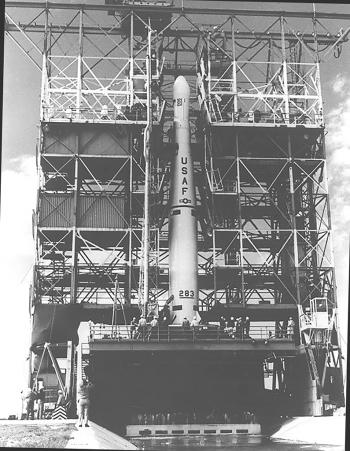
The last time a rocket lifted off from Florida to put a satellite into a polar orbit, the booster failed, raining debris over Cuba. Engine parts were reportedly handed over to Russia and China for analysis, and a story circulated about a not-so-proverbial sacrificial cow being felled by a falling piece of wreckage.
“Havana charged that a cow was killed in a deliberate U.S. action,” George Tenet, former director of the Central Intelligence Agency, said during a speech at the National Reconnaissance Office 40th Anniversary Gala on Sept. 27, 2000.
“The Cubans soon paraded another cow through the streets with a placard reading: ‘Eisenhower, you murdered one of my sisters.’ It was the first—and last—time that a satellite has been used in the production of ground beef,” Tenet quipped.
The incident spurred the U.S. to abandon polar launches from Florida and shift those missions instead to Pacific Coast launch sites in California and Alaska. But the restriction, which has remained in effect for nearly 60 years, is about to be lifted.
A new generation of rockets outfitted with automated flight safety systems is once again making the polar corridor an option for Florida launches, says U.S. Air Force Brig. Gen. (ret.) Wayne Monteith, who now serves as associate administrator for the FAA’s Commercial Space Transportation Office.
In 2016, when Monteith was the director of the Air Force’s Eastern Range at Patrick AFB, Florida, and the commander of the 45th Space Wing at Cape Canaveral, widespread fires in California temporarily shut down operations at Vandenberg AFB.
“The fires were so intense they took down power lines, and as I recall they melted some of the fiber-optic backbone,” Monteith tells Aviation Week. “There was a lot of consternation about what would happen if we needed to support . . . something into polar or sun-synchronous orbit and Vandenberg was unavailable.”
Monteith directed his team to start researching polar orbits from Cape Canaveral. “We really started it out as a sort of science project: Is it something that’s even possible, given the last anomaly?” he says.
In addition to the famed failed flight over Cuba, Monteith’s team found a few examples of rockets heading north from Florida to reach polar orbits. However, the problem with that trajectory is that vehicles have to dogleg around the Canadian province of Newfoundland to avoid first-stage flight over populated areas. “You lose a lot of energy when you go north,” says Monteith.
At the time, the Air Force was also working with SpaceX to test and certify an autonomous flight safety system (AFSS) for its Falcon rockets. The AFSS would alleviate the need for downrange tracking systems to relay a destruct signal in case the booster veered off course and posed a threat to populated areas.
“SpaceX at that time supplied us with notional flight data [for polar trajectory from the Cape], and we did the initial safety analysis,” Monteith says. “I say ‘initial’ because there was no projected mission at that time.”
There is now. SpaceX plans to launch Argentina’s Earth-observing Saocom 1B satellite from Cape Canaveral into a near-polar, sun-synchronous orbit about 390 mi. above Earth. The flight, originally targeted for late March, was postponed due to travel restrictions imposed to help combat the spread of COVID-19. The company also has not yet received its FAA license to fly.
“We are in the throes of doing the actual analysis, based on a launch that has been submitted for a license,” Monteith says. “It’s really pretty exciting if you think about it—for the first time in what would be 60 years doing this flight trajectory,” he adds. “What is allowing that to occur [are] the advances in technology.”
The SpaceX mission, which has not yet been rescheduled, will still overfly Cuba, but by then its first stage will have separated, leaving powered flight to the second stage. It will pass over Cuba at an altitude of about 300 mi., the FAA says.
Rockets flying east from Cape Canaveral typically have second-stage flight over Europe or Africa, so the polar trajectory is not considered any higher risk to public safety, the FAA analysis shows.
SpaceX is planning to fly up to seven polar missions from Florida a year, according to a draft environmental impact analysis posted on the FAA’s website. And it is not the only one looking at polar trajectories from the Cape.
“Once you had a company that could successfully demonstrate it, then you would anticipate that other companies may follow suit,” says Monteith. “You’re looking for that trailblazer to go through any regulatory and safety hurdles.”





